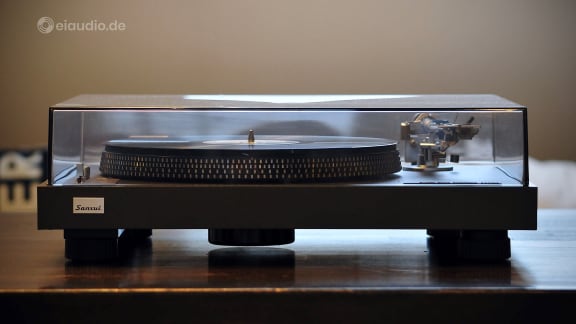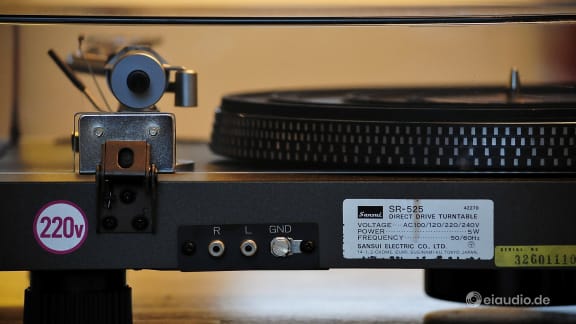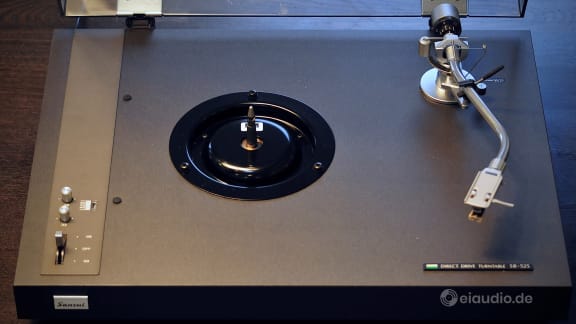Sansui SR-525
Published: 02/02/2021
Manufacturing date: 1976
Author: Karsten Hein
Category: Gear & Review
Tag(s): Turntables
Following the sale of our Tannoy DC6t speakers to a fellow audiophile in northern Germany, I again had some money to spend on explorations. Looking for improvements to make on our HiFi setup, I decided that much could be gained from upgrading the record player on our main system. While our Philips GA 212 still put out a solid performance, its tonearm and chassis did have some limitations in terms of cartridge upgrades, etc. For vinyl to sound even better, it was high time to change to a more sophisticated concept altogether.
I scanned the web for vintage offers and asked friends for suggestions. Among our choices were the typical Dual, Thorens, Denon, Technics and Micro Seiki brands, all offering well-known classics in their own right, but none of the more affordable ones looked attractive to me, until I came across an unlikely contender in the upper mid-market segment, the Sansui SR-525 DD. Based on a similar chassis and tonearm design as Sansui’s SR-323 belt-driven turntable, the SR-525 offers some significant upgrades, such as the quietest direct drive motor of its time and a quartz speed control with built-in strobe light. The technology is state of the art, especially for a 1976 machine, and I have read nothing but praise about this player.
This is no surprise, really. The Sansui Electric Company was founded by Kosaku Kikuchi in Tokyo, Japan in 1947. Similar to many of his contemporaries, Kosaku cut his teeth in the industry by manufacturing transformers and simple radio parts, until he realised that fluctuation in the quality of components was making it difficult for manufacturers to consistently assemble high quality devices. Kosaku therefore determined that Sansui should prioritise product quality over manufacturing cost. Later, as Sansui diversified into more complex products, this focus on quality proved to be beneficial to the reputation of the brand.
By 1954, Sansui was manufacturing preamplifiers and amplifiers that were sold both as kit for home assembly and as finished product. Although the first units were based on mono tube designs, stereo tube systems were introduced in 1958. By the mid-60s, Sansui’s internal and external design choices had earned the company a solid reputation for high quality audio products. It was at this time that the company started producing its iconic black-faced AU-series amplifiers. Among these were to be found many units that can well be classified as ‘High End’ and remain much sought after by audio enthusiasts until this day. The company produced its first turntable in 1967, a full nine years before the SR-525 came to life.
I found our SR-525 at a vintage HiFi dealer in Mannheim called ‘Goldladen’, combining the family name of its owner with the German word for shop. And although I had to pay a little extra for buying from a proper retailer, I liked the idea that I could drive there and inspect it, before making a purchase. Upon arriving at the shop, I found the Sansui to be in absolutely mint condition. With the platter raised, it was impossible to tell, if the motor had ever run, and there were hardly any scratches on the cover either. Standing in front of the SR-525, there is very little in its design, touch, and feel that makes it out to be a vintage player. In its simplicity and dark grey paint coat, it rather resembles the players around the turn of the century. The only item that gives it away are the clunky rubber feet, perhaps. But they do a fabulous job in keeping the record from skipping.
The tonearm is of sophisticated design with a suspended anti-skating weight and an additional lateral weight to keep resonances at bay. Its S-shape assures that the stylus angle is nearly perfect over most of the record’s surface. The Sansui’s total weight of nearly 10kg provides a solid base to absorb vibrations of any kind. At its original German sales price of 865,00 DM, it was nearly 200 DM more expensive than the belt-driven Philips, and this really shows. Other models in the SR series were the belt driven 323, the similar but wood finished 626, and the higher specced 929.
Do you have some personal experience with Sansui turntables? Please feel free to share your thoughts in the comments section below. Your perspective will be highly appreciated.
Specifications
- Type: manual direct drive turntable
- Platter: 310mm, die-cast aluminium alloy, 1,4kg
- Motor: 20-pole, 30-slot DC brushless
- Speeds: 33 and 45 RPM, servo-controlled
- Wow and flutter: < 0.03% WRMS
- Signal to noise ratio: > 64dB
- Rumble: > 72dB
- Tonearm: statically balanced, s-shaped, resonance-free, adjustable height
- Effective length: 220mm
- Overhang: 17,5mm
- Cartridge weight: 4 to 11g
- Dimensions: 46,9 x 15,0 x 37,5cm
- Weight: 9.5kg
- Year(s): 1976 - 1978
Purchased at:
www.goldladen-mannheim.de
Laurentiusstraße 26
68167 Mannheim
Tel.: 0151 241 643 55





